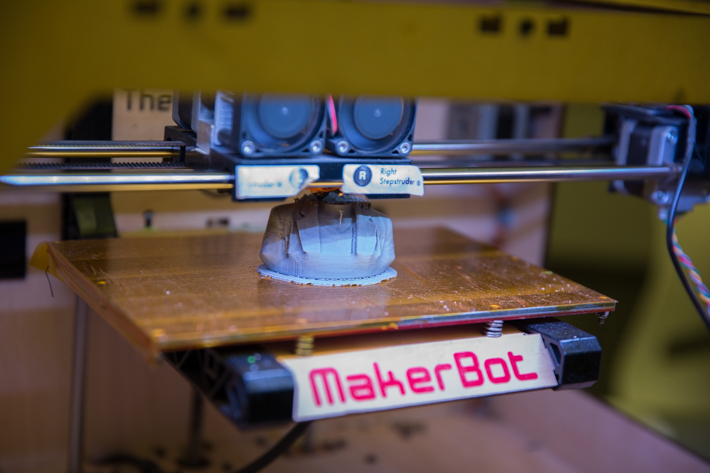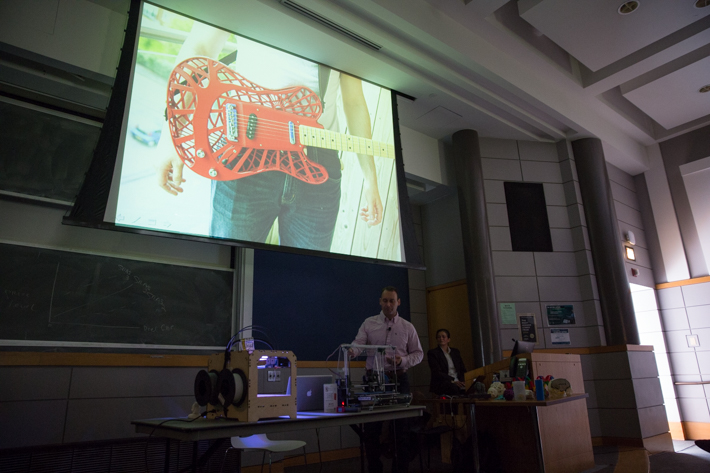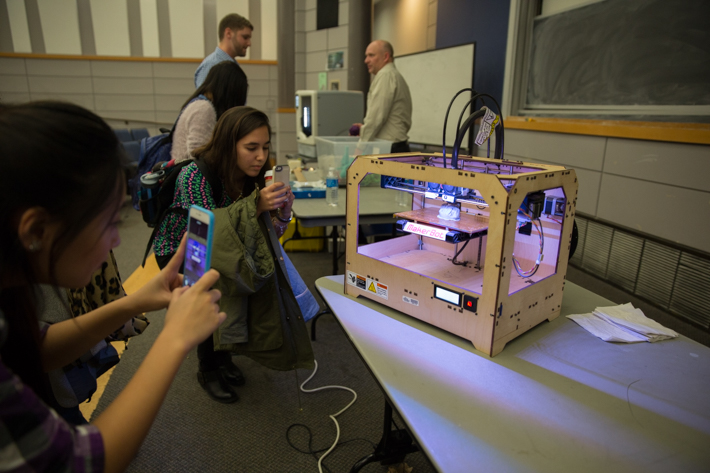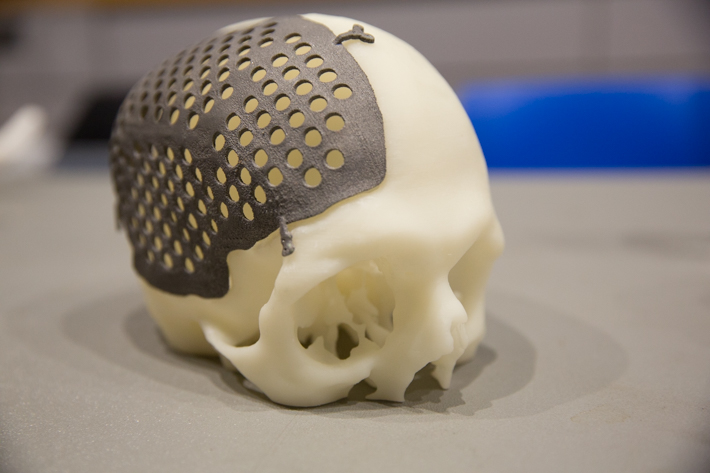Like most toddlers, Emma Lavelle wanted to color and play with blocks, but those simple youthful desires were beyond her reach. Emma suffers from Arthrogryposis Multiplex Congenita, a disease that turned her shoulders inward and pushed her legs up toward her ears at birth.
Some of what had been denied Emma came within her grasp when she received “magic arms”—the Wilmington Robotic Exoskeleton (WREX), an assistive prosthesis that supports her arms and back.
The WREX was created out of a durable plastic in miniature for Emma at Alfred I. duPont Hospital for Children in Wilmington, Del., using the Amtek Company’s Stratasys 3-D printer, a machine that creates three-dimensional objects using a process similar to an inkjet printer.
“This was the first time that I knew this technology was going to change things,” Amtek Consultant Alex Baddock told more than 200 George Washington University School of Business freshmen on Tuesday. “There are endless possibilities of what you can do with these printers, especially with medical applications.”
Since its development in the 1980s, 3-D printing has become a “disruptive technology” with the potential to transform a range of industries from medicine to defense and education. The innovation, which allows faster, cheaper manufacturing on demand, was a fitting topic of discussion for the Age of Globalization —a new course that asks GWSB freshmen to tackle the problems of their generation by creating an awareness campaign with an interdisciplinary approach.
“3-D printers are revolutionizing industries overnight. They are game-changers,” said course creator Scheherazade Rehman, the Steve Ross professorial fellow of international finance and business. “I truly believe a third industrial revolution is taking place today.”

The MakerBot was one of three 3-D printers on display during the "Age of Globalization" course on Tuesday for George Washington School of Business students.
GWSB freshman Gabrielle Roth, whose group campaign focuses on income inequality, said that she was excited to learn how 3-D printing is creating pathways to new markets.
“It was interesting to see how this kind of technology could be used in so many fields and possibly in everyday life,” Ms. Roth said.
Mr. Baddock—who recounted the story of Emma—discussed the implications of 3-D printing during a live demonstration on Tuesday along with Davide Prete, adjunct professor and sculpture coordinator at the Corcoran School of the Arts and Design; Darrell Hurt, section head of computational biology at the National Institutes of Health (NIH); Michael Weinberg, J.D. ’09, vice president at Public Knowledge; and Kenan Jarboe, president at Athena Alliance.
Students watched Mr. Prete perform a 360-degree scan, load the file of information into a computer design system and export the information to a printer that creates a detailed, scaled, 3-D model using materials such as plastic, metal or ceramics.

The demonstration organizer Davide Prete, adjunct professor and sculpture coordinator at the Corcoran School of the Arts and Design, showed a range of examples of applications for 3-D printers from music to fashion, sculpture, architecture, medicine—and even children's toys.
Mr. Prete, who organized the demonstrations, said 3-D printers are able to make single objects in different colors and multiple materials. They are used to create high fashion garments; elaborate, edible chocolate pastries; and models of human organs.
3-D printers also allow Emma to quickly receive an adjusted prosthesis as she grows.
A simple search for “3-D printers” on Amazon shows a range of basic 3-D printing machines priced from about a few hundred to a couple thousand dollars—and another $50-$100 for printing material—meaning more affordable hi-tech versions for the home could soon be on the horizon.
“In five years you will be able to have this world-class technology in your home,” Mr. Prete said. “It creates an enormous difference in the cost of production per unit, and artistically and architecturally this technology lets us explore things in a way we haven’t been able to before.”
Dr. Hurt, who helped launch the NIH 3-D Print Exchange in June at the White House Maker Faire, said that 3-D printing also has helped researchers better study pathogens such as Ebola and H1N1 using printed models.

NIH Computational Biology Section Head Darrell Hurt shows a 3-D printed model of the "H" in H1N1, the flu virus. He said that the NIH 3-D Print Exchange is using the technology to help researchers.
Displaying a highly detailed model of a skull with a metal plate attachment, Dr. Hurt described how a U.S. Army veteran of the Iraq War received a perfect patch for his skull following a head injury on the battlefield because doctors were able to scan his head and 3-D print a unique plate.
“You can build things that you can’t build in any other way, that are custom and unique to you,” Dr. Hurt said. “We are about 10 years out from developing organs for the human body.”
Because the technology is so new, 3-D printing has opened up a range of new legal issues, according to Mr. Weinberg. He said that 3-D printers have challenged intellectual property laws because they allow people to make physical objects based on designs and scans. Because physical objects are protected by patent under the law, but designs are covered by copyright, there is confusion over which laws apply to the overall process.
 Following the discussion, students asked the presenters questions and viewed the printers up close.
Following the discussion, students asked the presenters questions and viewed the printers up close.
“This technology forces you to recalculate your relationship with intellectual property,” Mr. Weinberg said.
Mr. Jarboe said that 3-D printing has even greater implications for future businessmen because it redefines what firms can achieve in the 21st century.
“It’s not just about the physical creation,” Mr. Jarboe said. “It’s about collaboration, ideas and design.”


